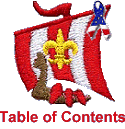
|
||
|
|
Scouting History in the Viking Council 1910-1976
|
|
Cover 1 2 3 4 5 6 7 8 9 10 |
|
as well as initiating semimonthly evening training sessions to be held in the schools. The Council then surveyed local organizations in business, government, industry and the health-care field to locate openings for Explorer Scouts who wished to volunteer for active part-time duty. As a result the Bloomington Police Force established an Explorer Post in which Scouts rid in squad cars on regular tours; General Mills has an Explorer Post in their computer section; Northwestern Bell in their secretarial department; and North Memorial Hospital established an Explorers medical Post. By 1971, the Explorer Career Scouting Program had proven so popular, and had received so much publicity among teenagers, that it was decided to open it to young women between 14 and 21 years old. This new and significant event in Scouting became instantly became popular, and the ranks of the Explorers expanded. By 1976 there were about 4,000 Explorer Career Scouts in the Viking Council, with the mix being about two-thirds young men and one-third young women. Explorer Career Scouts in the law enforcement field wear light-blue shirts and dark blue jackets and slacks to match the uniforms of their adult counterparts. Explorer career Scouts in other fields wore ordinary dress or their standard uniform of green shirt and slacks highlighted by a white web bet, which was initiated in 1958. In 1970, over 6,000 Scouts gathered at Bunker Prairie Park near Anoka for a great Camporall in celebration of the anniversary of the 60th anniversary of the founding of Scouting in this country. Arch Pease of Anoka served as general Chairman of this event and he was assisted with the logistics by members of the Minnesota National Guard. The Viking Council was
headed in 1970 by the senior vice president of Northwestern National
Bank of Minneapolis, Willis F. Rich Sr. He provided inspiring
leadership to |
the organization which now numbered over 30,000 boys and 9,000 adult volunteers. In 1971 a unique event took place when then Governor Wendell Anderson presented the William T. Hornaday medal, Scouting's highest conservation award, to three teenage brothers from Bloomington. Receiving the coveted award were Richard, Shreve and Jay Gould. To earn the Hornaday Award the Gould brothers conducted numerous conservation projects, and engaged in many demonstrations and exhibits. These included the rearing of more than 2,000 pheasants; hundreds of tree plantings; and the development of a hardwood tree nursery. The award is very difficult to earn, and this was the first time that three members of one family qualified. Scouting had grown so rapidly that by 1971, the facilities used for headquarters were inadequate, and a search began for new Council offices. Committees were formed to review the membership of the Council, and determine what location could best serve the membership now aggregating over 30,000. After careful review it was decided that the area around Highways 12 and 100 just west of the city would be the best location. However, land there was at a premium, so the idea of building did not move forward until 1973 when an existing building became available for purchase at 5300 Glenwood Avenue - just one block from the ideal site. The wheels of progress turned quickly, and the building was secured, remodeled, and the office opened in time for the National Meeting of the Boy Scouts of America held in Minneapolis in May of 1973. Throughout the history of Scouting in Hennepin County, as the movement grew from 20 troops to close to 1,000 units in 1975, the fundamentals of Scouting had not changed. The idea of character building, citizenship training and physical fitness are as much a part of the program as they were when Baden-Powell first developed the idea. Scouting had reached its 67th birthday at the time of this writing and the program in Hennepin County had grown strong and thrived because of the solid groundwork laid by innumerable concerned citizens of the community. Mindful of the past, and grateful to many farsighted individuals, we look forward to the future with great hope for an even stronger and more useful program for young people. |
|
|
Cover 1 2 3 4 5 6 7 8 9 10 | |
|
The
ScoutingBSA.org web site is a
legacy site of the Viking Council BSA, now Northern Star Council.
|
|
||||||
Last Update May 15, 2023

.jpg)